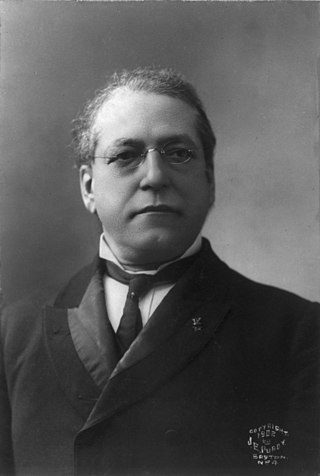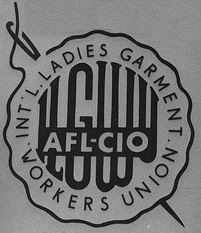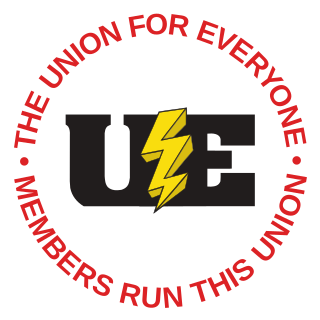Related Research Articles
A trade union or labor union, often simply referred to as a union, is an organization of workers whose purpose is to maintain or improve the conditions of their employment, such as attaining better wages and benefits, improving working conditions, improving safety standards, establishing complaint procedures, developing rules governing status of employees and protecting and increasing the bargaining power of workers.

The Labor Management Relations Act of 1947, better known as the Taft–Hartley Act, is a United States federal law that restricts the activities and power of labor unions. It was enacted by the 80th United States Congress over the veto of President Harry S. Truman, becoming law on June 23, 1947.

John Llewellyn Lewis was an American leader of organized labor who served as president of the United Mine Workers of America (UMW) from 1920 to 1960. A major player in the history of coal mining, he was the driving force behind the founding of the Congress of Industrial Organizations (CIO), which established the United Steel Workers of America and helped organize millions of other industrial workers in the 1930s, during the Great Depression. After resigning as head of the CIO in 1941, thus keeping his promise of resignation if President Franklin Delano Roosevelt won the 1940 election against Wendell Willkie, Lewis took the United Mine Workers out of the CIO in 1942 and in 1944 took the union into the American Federation of Labor (AFL).

Samuel Gompers was a British-born American cigar maker, labor union leader and a key figure in American labor history. Gompers founded the American Federation of Labor (AFL) and served as the organization's president from 1886 to 1894, and from 1895 until his death in 1924. He promoted harmony among the different craft unions that comprised the AFL, trying to minimize jurisdictional battles. He promoted thorough organization and collective bargaining in order to secure shorter hours and higher wages, which he considered the essential first steps to emancipating labor.

The American Federation of Labor was a national federation of labor unions in the United States that continues today as the AFL–CIO. It was founded in Columbus, Ohio, in 1886 by an alliance of craft unions eager to provide mutual support and disappointed in the Knights of Labor. Samuel Gompers was elected the full-time president at its founding convention and was re-elected every year except one until his death in 1924. He became the major spokesperson for the union movement.

The One Big Union is an idea originating in the late 19th and early 20th centuries amongst trade unionists to unite the interests of workers and offer solutions to all labour problems.

The nature and power of organized labor in the United States is the outcome of historical tensions among counter-acting forces involving workplace rights, wages, working hours, political expression, labor laws, and other working conditions. Organized unions and their umbrella labor federations such as the AFL–CIO and citywide federations have competed, evolved, merged, and split against a backdrop of changing values and priorities, and periodic federal government intervention.

The International Ladies' Garment Workers' Union (ILGWU), whose members were employed in the women's clothing industry, was once one of the largest labor unions in the United States, one of the first US unions to have a primarily female membership, and a key player in the labor history of the 1920s and 1930s. The union, generally referred to as the "ILGWU" or the "ILG", merged with the Amalgamated Clothing and Textile Workers Union in the 1990s to form the Union of Needletrades, Industrial and Textile Employees (UNITE). UNITE merged with the Hotel Employees and Restaurant Employees Union (HERE) in 2004 to create a new union known as UNITE HERE. The two unions that formed UNITE in 1995 represented 250,000 workers between them, down from the ILGWU's peak membership of 450,000 in 1969.

The United Electrical, Radio and Machine Workers of America (UE), is an independent democratic rank-and-file labor union representing workers in both the private and public sectors across the United States.

The International Longshoremen's Association (ILA) is a North American labor union representing longshore workers along the East Coast of the United States and Canada, the Gulf Coast, the Great Lakes, Puerto Rico, and inland waterways; on the West Coast, the dominant union is the International Longshore and Warehouse Union. The ILA has approximately 200 local affiliates in port cities in these areas.

The Great Railroad Strike of 1922, or the Railway Shopmen's Strike, was a nationwide strike of railroad workers in the United States. Launched on July 1, 1922 by seven of the sixteen extant railroad labor organizations, the strike continued into August before collapsing. A sweeping judicial injunction by Judge James Herbert Wilkerson effectively ended the strike on September 1, 1922.

Labor unions represent United States workers in many industries recognized under US labor law since the 1935 enactment of the National Labor Relations Act. Their activity today centers on collective bargaining over wages, benefits, and working conditions for their membership, and on representing their members in disputes with management over violations of contract provisions. Larger labor unions also typically engage in lobbying activities and electioneering at the state and federal level.

Union busting is a range of activities undertaken to disrupt or weaken the power of trade unions or their attempts to grow their membership in a workplace.
Union dues are regular payments made by workers which grant membership of a trade union. Dues fund the provision of union services such as representation in collective bargaining and education activities. Nearly all unions require their members to pay dues. Dues can be collected directly or indirectly from workers; in the case of indirect collection this is often through a check-off where a worker authorises an employer to transfer the membership dues, from their wages, to their trade union.

Amalgamated Association of Iron and Steel Workers (AA) was an American labor union formed in 1876 to represent iron and steel workers. It partnered with the Steel Workers Organizing Committee of the CIO, in November 1935. Both organizations disbanded May 22, 1942, to form a new organization, the United Steelworkers.
The Union Labor Party was a San Francisco, California working class political party of the first decade of the 20th century. The organization, which endorsed the doctrine of nativism, rose to prominence in both the labor movement and urban politics in the years after 1901, electing its nominee as Mayor of San Francisco in 1901, 1903, 1905, and 1909.
SEIU Member Activists for Reform Today (SMART) is a national organization of rank-and-file union members working for the democratic reform of the Service Employees International Union (SEIU). SEIU primarily represents workers in the public sector, healthcare industry, and property services. Today it is America's largest and fastest growing union with 2 million members, many of whom are minorities, immigrants, and women.
Citizens' Alliances were state and local anti-trade union organizations prominent in the United States of America during the first decade of the 20th century. The Citizen's Alliances were closely related to employers' associations but allowed participation of a broad range of sympathetic citizens in addition to those employers apt to be affected by strikes. Originating in the American state of Ohio as the "Modern Order of Bees," the Citizens' Alliance movement spread westwards, playing a particularly important role in labor relations in the states of Colorado and California. Citizens' Alliance groups often worked in tandem with smaller but better financed employers' organizations interested in establishing or maintaining open shop labor conditions, including the Mine Owners' Associations (MOA) or the National Association of Manufacturers (NAM).

Reuben George Soderstrom was an American leader of organized labor who served as President of the Illinois State Federation of Labor (ISFL) and Illinois AFL-CIO from 1930 to 1970. A key figure in Chicago and Illinois politics, he also played a pivotal role in American labor history by helping to define national labor policy after the formation of the AFL–CIO in 1955. Soderstrom advised and was courted by multiple U.S. presidents seeking his endorsement and the votes of the over 1.3 million laborers he represented. The longest-serving state federation chief in American labor history, he passed seminal labor legislation and increased his organization's membership five-fold, transforming it into one of the most powerful labor bodies in the United States.

The Los Angeles streetcar strike of 1919 was the most violent revolt against the open-shop policies of the Pacific Electric Railway Company in Los Angeles. Labor organizers had fought for over a decade to increase wages, decrease work hours, and legalize unions for streetcar workers of the Los Angeles basin. After having been denied unionization rights and changes in work policies by the National War Labor Board, streetcar workers broke out in massive protest before being subdued by local armed police force.
References
- ↑ Wakstein, Allen M. (December 1964). "The Origins of the Open-Shop Movement, 1919-1920". The Journal of American History. 51 (3): 460–475. doi:10.2307/1894896. ISSN 0021-8723. JSTOR 1894896.
- 1 2 3 "American Plan". TheFreeDictionary.com. Retrieved September 26, 2017.
- 1 2 Kochan, Thomas A.; et al. (1984). Worker Participation and American Unions. Threat or Opportunity?. ISBN 9780880990226.
- 1 2 3 "American Plan". www.encyclopedia.chicagohistory.org. Retrieved September 26, 2017.
- ↑ Wakstein, Allen M. (December 1, 1964). "The Origins of the Open-Shop Movement, 1919-1920". The Journal of American History. 51 (3): 460. doi:10.2307/1894896.
- ↑ Dunn, Robert W.; Nearing, Scott (1927). The Americanization of labor. The employers' offensive against the trade unions. With an introd. by S. Nearing. Prelinger Library. New York : International Publishers.
- ↑ Soderstrom, Carl; Soderstrom, Robert; Stevens, Chris; Burt, Andrew (2018). Forty Gavels: The Life of Reuben Soderstrom and the Illinois AFL-CIO. 1. Peoria, IL: CWS Publishing. pp. 165–167. ISBN 978-0998257532.